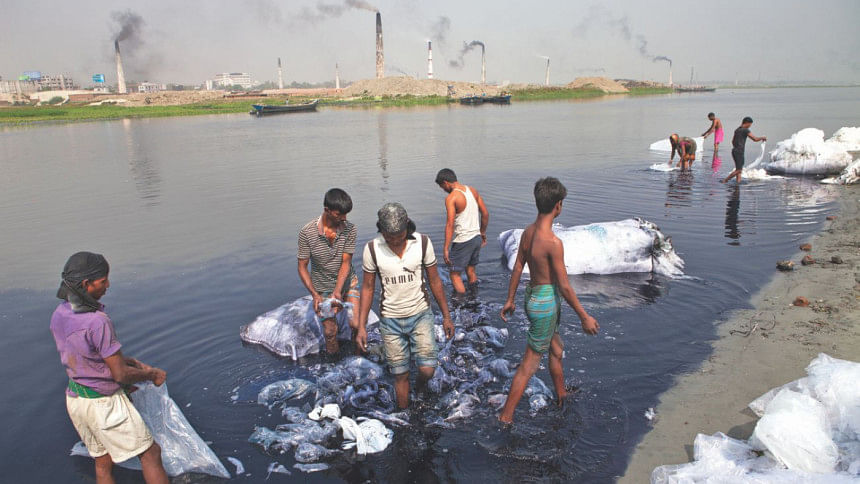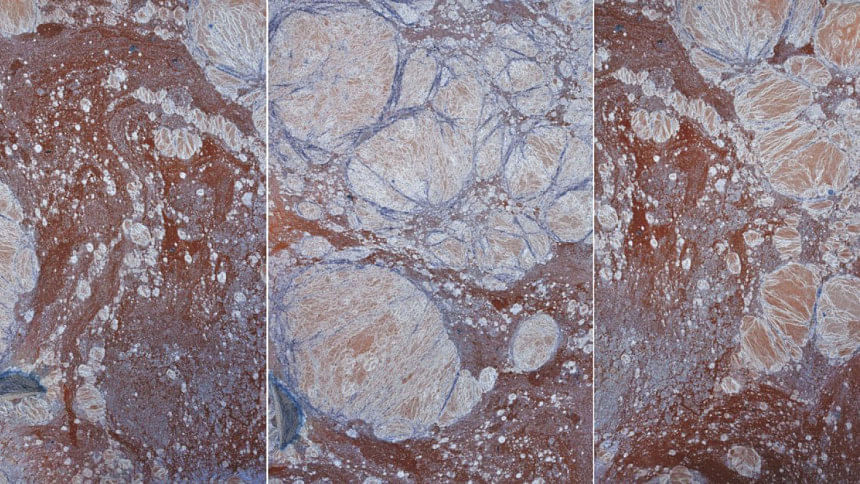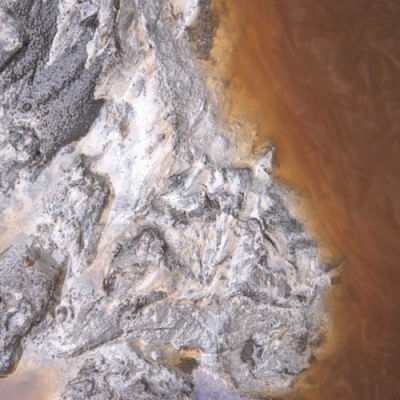Dark Flows the River Turag

The waters of the Turag flow alongside Dhaka's industrial suburbs of Tongi, Gazipur and Savar, lined with dyeing and finishing factories. The river was once surrounded by agricultural land and the water was used mainly for fishing and transportation. Nowadays, the area is mostly inhabited by people who directly or indirectly work in the textile industry.
Hashem Ali is a boatman in Konabari area of Gazipur who transports passengers from one side of the Turag river to the other. Ali explains that the water is relatively clear during the monsoon due to heavy rainfall but becomes completely dark during the drier season with waste from wet processing factories. He says, “The water reeks of chemicals and we can barely stay on it.” Konabari hosts 33 washing, dyeing and finishing units that operate and consume about 13 billion litres of fresh water a year.
Sagorika Banu, a resident of Gacha area who lives near the banks of the Turag, says that the area becomes unliveable due to the stench. “We use the river for all sort of purposes—bathing, washing pots, laundry—all of it becomes futile once dyeing pollutes the water. There are so many mosquitoes and the kids get rashes sometimes,” she adds. She explains that the community draws water using a motor pump during the dry season when the river is entirely unusable.
In 2013, New York Times surveyed the communities affected by factories in Savar, the largest industrial belt near Dhaka. They profiled a local school in Genda area where mostly children of factory workers were enrolled. The children regularly experienced fainting and nausea resulting from inhaling contaminated air from polluted water bodies. The school headmaster complained of low concentration amongst students due to the intense smell of toxins.
Textile industry is the life and pride of Bangladeshi economy, representing 82 percent of Bangladeshi exports and 6 percent of global market. Yet the industry regularly faces criticism for its production process. And rightly so: industrial waste is responsible for 60 percent of Dhaka's water pollution, textile being one of the leading contributors. The brunt of this ecological hazard is unfairly experienced by grassroot communities—workers, boatmen, and farmers—even though the harmful effects are a result of business' profit-hungry habits.
The International Finance Corporation (IFC) states that the industry consumes 1,500 billion litres of groundwater annually, a remarkable five times larger than the best practise benchmark. That is equivalent to the water needs of 800,000 people annually. This results in Dhaka's water level decreasing by 2.5 percent every year and may result in long-term groundwater depletion.

Syed Hafizur Rahman, Professor of Environmental Sciences at Jahangirnagar University, explains that wet processing factories release effluents which is alkaline wastewater with dyes containing toxic substances such as chlorine, chromium, zinc, and copper into surrounding water bodies. This not only creates a crisis for clean water but also results in agriculture lands becoming inundated with toxins, fish stocks dying, and people suffering from health problems. He further explains, “Harmful effects are transported through food chain causing adverse impacts on the public health.”
Professor Rahman says that “effluents from textile factories will not harm humans and the environment if treatment process, as suggested in the design, is properly implemented.” Indeed, most wet processing factories are required to include an Effluent Treatment Plants (ETP) in their factory designs in order to receive licenses from the Department of Environment (DoE). Yet, as revealed in New York Times' 2013 report, many ETPs are underutilised due to the costs it incurs. Businesses, it seems, choose to value profits over the negative effects their production process has on society.
Faruque Hassan, Senior Vice-President of Bangladesh Garments Manufacturers and Exporters Association (BGMEA), states that some factories do not host ETPs due to shortage of factory space, in which case, those businesses are requested by both BGMEA and the government to relocate—but this opinion has been contested by DoE's Additional Director General, Quazi Sarwar Imtiaz Hashmi.
Hashmi says that factories with limited space are advised to collaborate with other factories and use a central ETP. Another DoE official from the enforcement division claims that there has not been any incident of this sort in the past. When asked about their monitoring procedure, Hashmi reported that routine inspections are carried out and random samples from ETPs are regularly brought in for testing but they were unable to provide a comprehensive account of past routine checks due to time constraints.
In 2015, Bangladesh Bank set up a special “green” fund of $500 million USD to help textile industry adapt eco-friendly technologies. However, according to BGMEA officials, the fund is not inclusive and is not accessible for Small and Medium Enterprises (SME) due to high eligibility requirements. BGMEA officials were unable to reveal further information on how much of the fund has been utilised so far—and for what purposes—and how much remains.

Despite regulations mentioned in Bangladesh Environment Protection Act, 1995, and The Environment Conservation Rules 1997, effluent discharge in Turag river continues, and environmental and trade institutions alike have repeatedly echoed the need to close loopholes in the system. “The problem is not with environmental laws but with enforcement,” says environmental lawyer, Syeda Rizwana Hasan, “There is no gap in the policies; it's not like any chemical has been missed in the law handbook. Everything is there but not being complied accordingly.”
Hashmi also mentions that the department is planning to move to an automated system to ensure stricter monitoring; a formal proposal has been sent to Prime Minister's office as part of Digital Bangladesh 2021 programme. He says, “The system will incorporate sensors at discharge outlets to automictically detect any violation to the allowed effluent discharge ratios.”
Hashmi further brings attention to business' reluctance to comply with rules and regulations. He says, “For any factory that violates existing environmental law regarding effluent discharge, we penalise them heavily almost summing up to crores. Even then, the business appeal to court and get their fine reduced to almost a third of the original.” When asked about why the polluting factories' licenses were renewed, Hashmi elaborates, “We don't believe in harsh measures such as cancelling license since it hampers the whole industry; instead, we choose a rehabilitating approach where the factory is forced to learn from their mistakes.”
This sort of reduced penalty appeal was often requested and pursued by BGMEA in the past, according to Senior Vice-President, Faruque Hassan. However, Hassan claims that the BGMEA's stance on environmental responsibility has become firm over the years. He further asserts that the mindset of business owners is changing. He says, “Plenty of environment friendly policy is now coming from top management.”

Hassan emphasises, yet again, the government's crucial role in ensuring environmental safety. “In our country, nobody will take a proactive decision unless they are forced to. Giving fines of Tk.10-20 lakh will not cause Bangladeshi garments owners to change the way they function. Therefore, government has to be stricter in this case,” he reiterates.
Hassan also believes that buyers have a responsibility in ensuring compliance with environment laws. He says, “We [BGMEA] encourages buyers—who visit site almost every day—to cooperate with us and make sure only factories with functioning ETP receives orders. It falls within buyers' obligations too since they must follow local laws if they are buying from Bangladesh.”
Buyers are indeed complicit in the environmental disaster created by the textile industry. However, there seems to be a lack of international interest in taking responsibility for such a paradigm shift. Apart from H&M, none of the major buyers of Bangladeshi clothes have shown interest in pushing for environmentally conscious business module. Often buyers overlook the environmental cost of a product in order to minimise their gross cost and maximising their profits. The global fashion industry is currently the world's biggest polluter after oil. And an unfavourable dynamic exists where economically developing and environmentally vulnerable countries like Bangladesh suffer greater consequences in this production model.
What the whole situation looks like, thus far, is a blame game where everyone is pointing their fingers at the other direction. If everybody is doing their parts as they claim to be, then why are the streams of Turag the colour of ink during winter? All involved stakeholders: government, businesses, and environmentalists, must take up a proactive role to ensure safety for the local community and ecosystem. The individuals that work in dyeing and finishing factories and those who live near the factory area are the ones being adversely affected by effluent discharge. Businessmen, government officials, buyers, and environmentalists all reside in the comfort of urban Dhaka, away from the stench of the polluted waterways. The locals lack the education and instrument to mobilise their rights and therefore, greater responsibility lies with the parties who do have access to realise their moral and social obligations to the community.





Comments